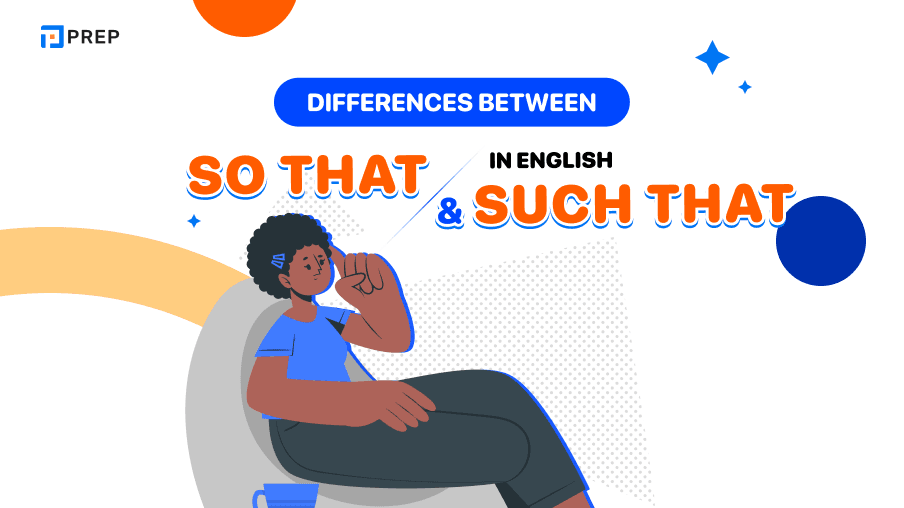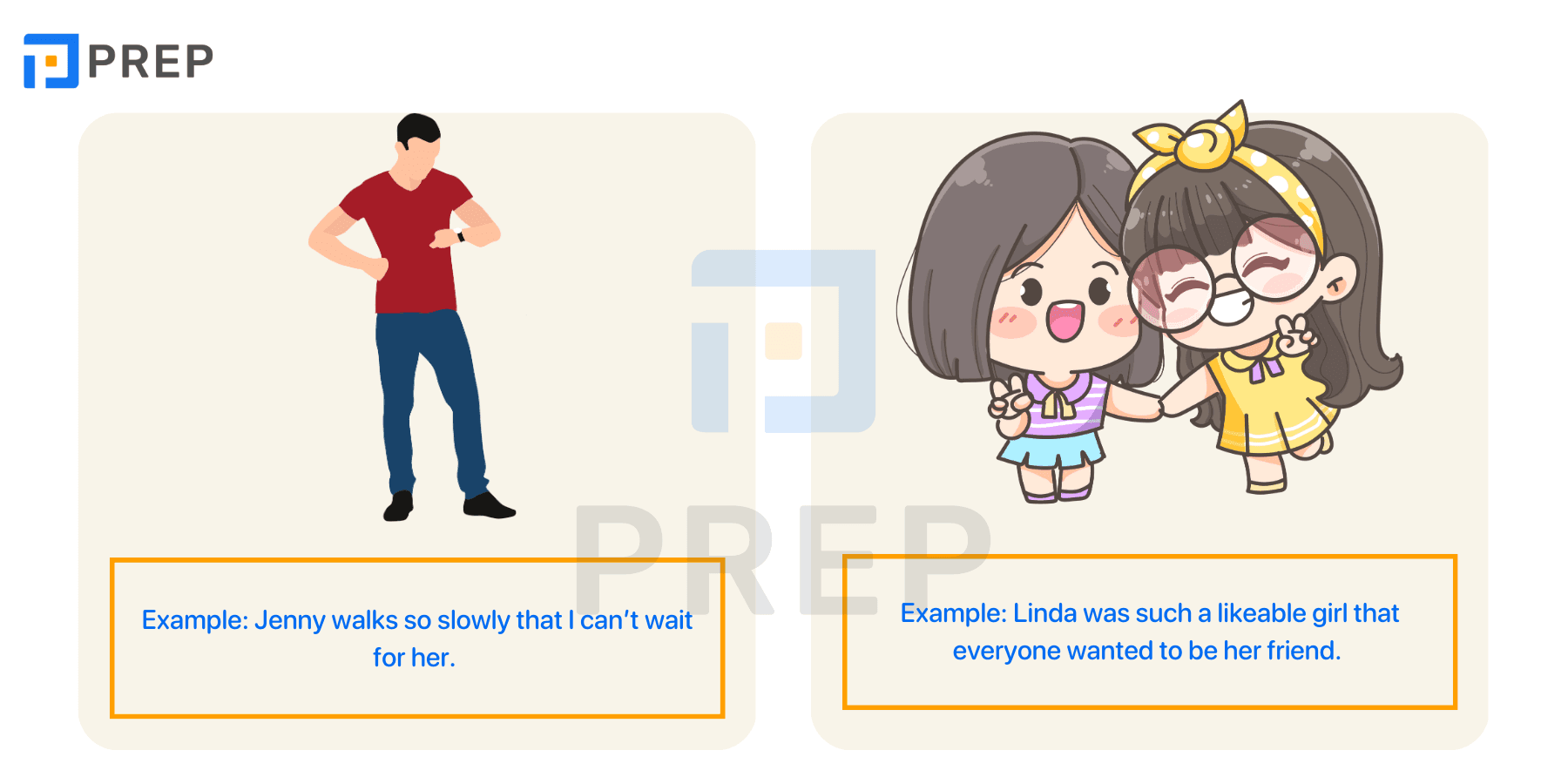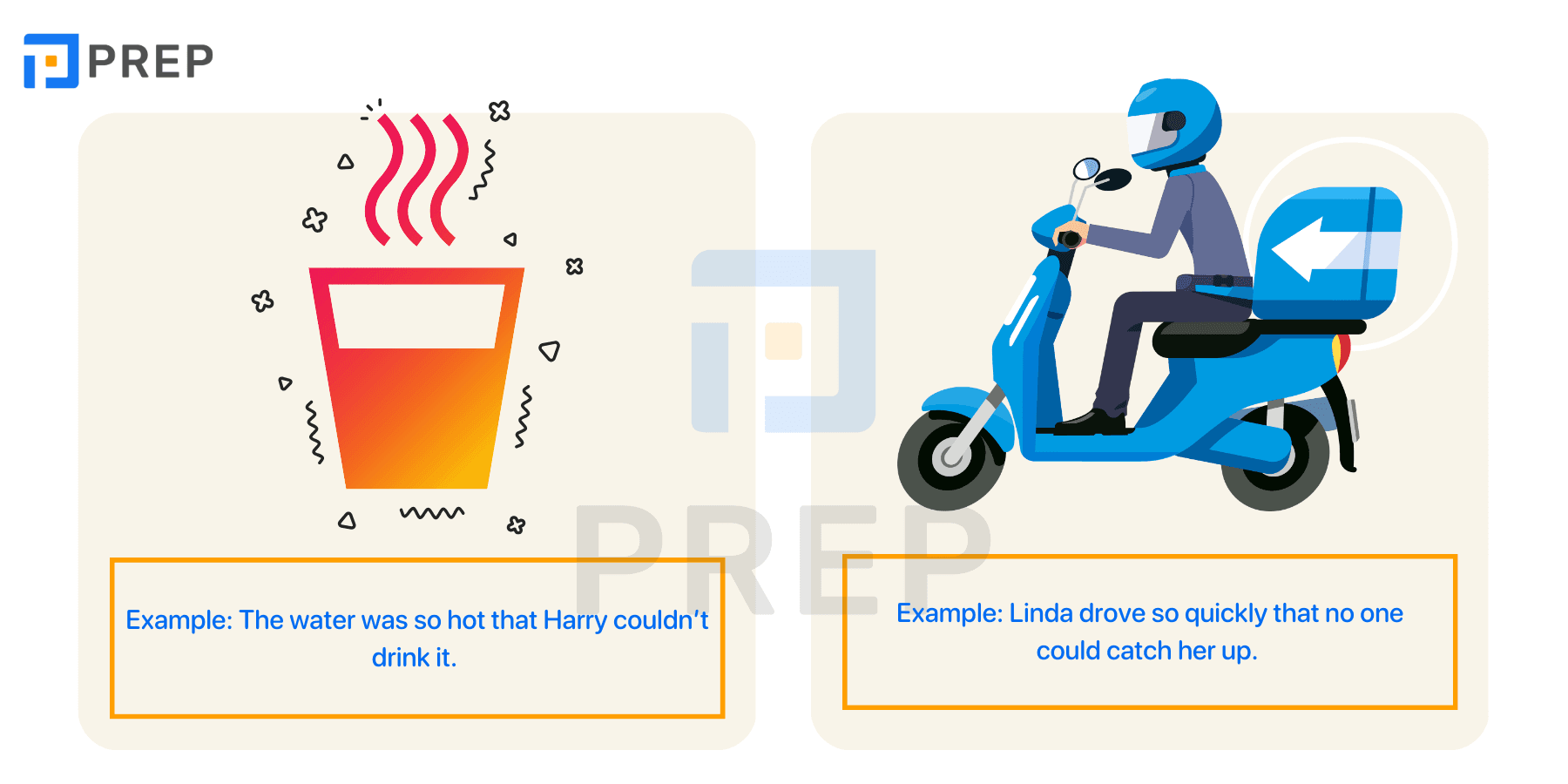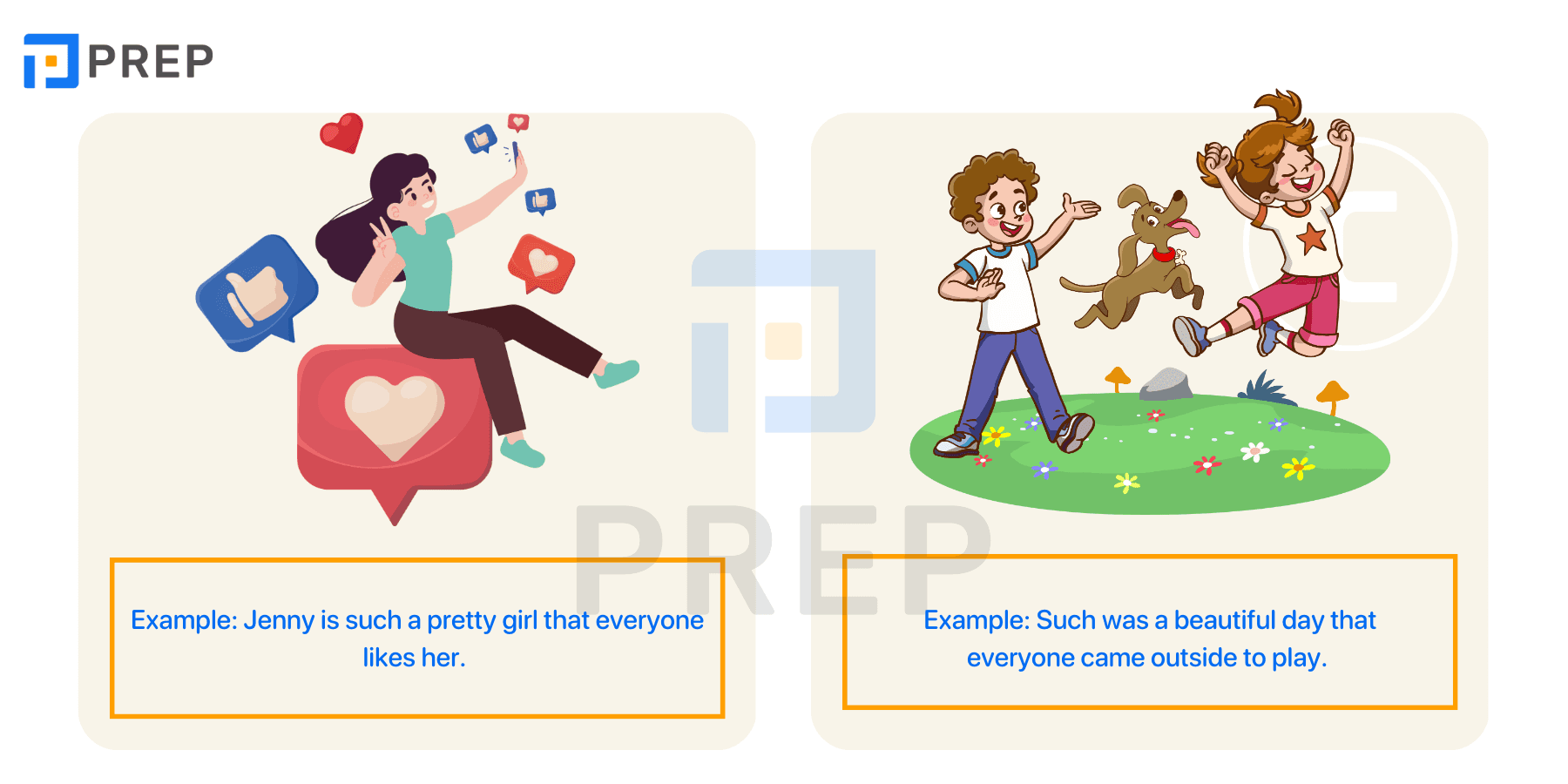So that and Such that Explained with Tips, Rules, and Practice
“So that” and “Such that” often confuse English learners. This guide explains their grammar rules, key differences, and common mistakes. You’ll also find practical examples, exam-focused applications, and exercises to help you master both structures with confidence.

I. What Are “So that and Such that”?
So that and Such that are two grammatical structures used to express purpose, cause-effect, or degree-result relationships in English sentences. Although they look similar and both include the word “that” they serve slightly different functions and follow distinct patterns.
These structures are common in both everyday English and academic writing, especially in contexts where the result or purpose of an action needs to be clearly stated.
Definitions and Functions
- So that is often used to show purpose or intended result.
Example: I lowered my voice so that she couldn't hear me. - Such that is typically used to emphasize degree or intensity leading to a result.
Example: His influence was such that everyone in the room fell silent.
In short:
- So that = “in order to” / “with the result that”
- Such that = “to such a degree that” / “resulting in a specific outcome”

Common Structures
Below are the basic sentence patterns for each:
- So that + subject + modal verb (can, could, will, would, may...) + base verb
Example: She studies hard so that she can pass the exam. - Such + (adjective) + noun + that + subject + verb
Example: It was such a boring film that we left halfway through.
Understanding these two structures will help you improve clarity and variety—review other subordinating conjunctions for range.

1. Key Differences Between So that and Such that
Although So that and Such that can both express results or consequences, they differ in form, focus, and formality. Understanding these distinctions will help you choose the right structure for each sentence.
Form and Sentence Construction
|
Feature |
So that |
Such that |
|
Common form |
So that + subject + modal verb + base verb |
Such + (adjective) + noun + that + subject + verb |
|
Example |
She spoke quietly so that no one would hear her. |
It was such a loud noise that everyone turned around. |
|
Sentence type |
Usually follows a cause → intended result logic |
Used to emphasize degree/intensity → result |
Usage Focus
- So that emphasizes the purpose or goal of an action
Example: He studies late so that he can pass the test. - Such that emphasizes the intensity or extent of a condition leading to a result
Example: The problem was such that we had to cancel the meeting.
Register and Context
- So that is more common in spoken English and general writing
Example: It’s commonly used in conversations, instructions, or informal essays. - Such that feels more formal and often appears in academic or technical writing
Example: Useful in essays, reports, and presentations that aim for a more polished tone.
Frequency of Use
- Learners and native speakers tend to use “so that” more frequently in both speaking and writing.
- “Such that” is less common, but effective when expressing cause-effect relationships in precise or high-level writing.
2. How to Use So that and Such that?
Using So that and Such that effectively requires a clear understanding of when each structure should be applied. Choosing the right form depends on your intended meaning, the level of formality, and the flow of your sentence. Below is a step-by-step guide to help you use them confidently in both everyday and academic contexts.
Choose the Right Structure Based on Purpose
- Use so that to indicate the purpose or intended result of an action.
- Use such that to express intensity or degree that leads to a specific consequence.
Practical Examples in Everyday and Academic Contexts
- Examples in everyday use:
He left early so that he wouldn’t miss the bus.
It was such a funny movie that we couldn’t stop laughing. - Examples in exam or academic writing:
The data revealed a trend such that further research became necessary.
The government revised the policy so that economic stability could be maintained.
Common Mistakes and How to Avoid Them
- Incorrect: She worked hard such that she could buy a car.
Correct: She worked hard so that she could buy a car. - Incorrect: It was so difficult task that no one completed it.
Correct: It was such a difficult task that no one completed it.
Tips to avoid confusion:
- "So that" is followed by a full clause, including a subject and verb.
- "Such that" includes the structure "such + adjective + noun + that..."
These two expressions are not interchangeable. Each serves a specific role in expressing either purpose or intensity-result logic.
When to Avoid or Replace These Structures
- In casual situations, alternatives like "so" or "because" may feel more natural.
Example: He studied a lot because he wanted to pass the test. - In formal or high-level academic writing where varied sentence structure is important, you can also consider alternatives such as:
- "in order that"
- "to the extent that"
- "as a result"
Choose the structure that best fits your tone, clarity, and context—try correlative conjunctions for parallel emphasis.

II. Applications in English Learning and Exams
Understanding how to use So that and Such that correctly can improve both your grammatical range and coherence in writing and speaking tasks. These structures are especially useful in standardized English exams such as IELTS, TOEFL, or other academic tests.
Using “So that and Such that” in IELTS Writing
In IELTS Writing Task 2, linking ideas clearly is essential for achieving a higher band score in coherence and cohesion. Both structures can be used to express purpose and result, showing logical development in your arguments.
Example (band 7–8 level):
- The government should provide more vocational training so that young people can gain practical skills for employment.
- Air pollution has increased to such an extent that serious health problems are now common in major cities.
These structures help:
- Vary sentence patterns
- Signal intended outcomes or cause-effect relationships
- Strengthen the academic tone of the writing
Using “So that and Such that” in TOEFL or Academic Contexts
In TOEFL Independent and Integrated Writing tasks, these structures can:
- Clarify the reason behind an action
- Emphasize the impact or degree of a problem
- Connect two related ideas across complex sentences
They are also applicable in presentations, summaries, and academic discussions where logical connections are necessary.
In Speaking or Classroom Use
While “So that” is more commonly used in speaking, using either structure accurately shows strong command of English and awareness of academic expression.
Example:
- I studied every night so that I could feel more confident during the exam.
- His explanation was such that even beginners could understand the lecture.
Regular use of these structures in speaking practice resources, model answers, or class presentations will increase your fluency and expression clarity.
III. Equivalent structures for So that and Such that
While So that and Such that are useful for expressing purpose or result, English offers several alternative expressions that can be substituted depending on the context, formality, and style of writing. Using these alternatives appropriately can diversify your sentence structures and improve the flow of your speaking or writing.
Common Equivalent Structures
|
Target Structure |
Possible Equivalent(s) |
Usage Context |
Example Sentence |
|
So that |
in order that / so / to / for the purpose of |
Formal and semi-formal contexts; often used in academic writing |
She revised thoroughly so that she could pass the exam. → in order that she could pass. |
|
Shorter forms may be preferred in spoken English |
He left early so he wouldn't miss the meeting. |
||
|
Infinitive of purpose often used in written instructions |
They studied together to prepare for the test. |
||
|
Such that |
to such an extent that / to the degree that / with the result that |
Used to show extent, typically found in formal or academic registers |
The storm was such that all flights were cancelled. → to such an extent that all flights were cancelled. |
Notes on Usage
- Use “in order that” instead of “so that” when a more formal tone is desired, especially in essays.
- Use “to such an extent that” as a more explicit alternative to “such that” when emphasizing severity or consequence.
- Be careful not to use these structures interchangeably unless the sentence meaning remains intact.
When to Use Alternatives
- To avoid repetition in formal essays (especially at band 7.0+)
- To adapt the tone of your writing or speaking (formal vs. informal)
- To develop more flexible sentence construction styles during IELTS or TOEFL preparation
IV. Practice with So that and Such that
To fully understand and use So that and Such that accurately, learners need to apply them in various sentence contexts. Below are practice activities that focus on grammar awareness, sentence building, and error correction—useful for classroom tasks, self-study, or exam preparation.
Exercises 1. Fill in the Blank (Choose “So that” or “Such that”)
Complete each sentence using the correct structure.
- He spoke slowly ______ the audience could follow.
- It was ______ a boring lecture that half the students fell asleep.
- She trained every day ______ she could improve her score.
- Their results were ______ that the board launched an investigation.
- I left a note ______ you wouldn’t forget to call.
Exercises 2. Rewrite Sentences Using the Other Structure
Transform the sentence using the opposite structure, while keeping the same meaning.
- It was such a loud noise that we couldn’t concentrate.
→ __________________________________________________. - He studied hard so that he could win the scholarship.
→ __________________________________________________.
Exercises 3. Error Correction
Identify and correct the incorrect use of “So that” or “Such that.”
- She was tired so that she went to bed early.
- He gave such a detailed explanation so that everyone could understand.
- We arrived early such that we catch the train.
Answer
[prep_collapse_expand open_text="View more" close_text="Show less"]
|
Exercises 1 |
Exercises 2 |
Exercises 3 |
|
|
|
[/prep_collapse_expand]
Above, PREP has shared detailed explanations, usage guides, and key differences between So that and Such that in English grammar. If you still have questions or would like more examples, feel free to leave a comment below—PREP will get back to you as soon as possible!

Hi I'm Chloe, and I am currently serving as an Product Content Administrator at Prep Education. With over five years of experience in independent online IELTS study and exam preparation, I am confident in my ability to support learners in achieving their highest possible scores.
Comment
Premium content
View allPersonalized roadmap
Most read












